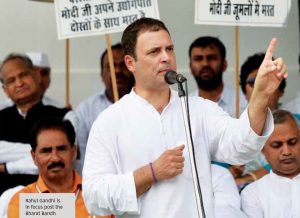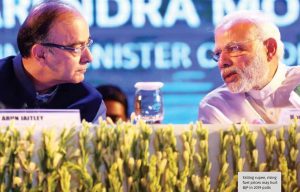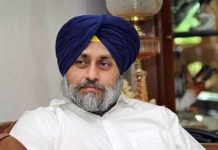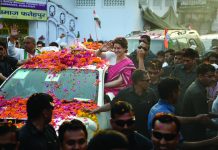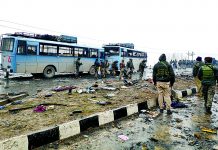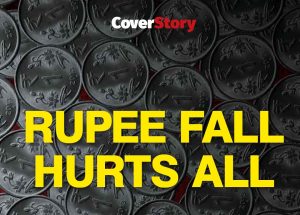 The rupee has just hit a new all-time low and for the time crossed the 72 mark for the even as US dollar eased a bit in global markets. When I filed my cover story “Fuel on Fire” sometime back for Tehelka, little did I know that the predictions would be so true and come prophetic. In few months rupee has fallen to abysmally low levels and fuel prices further skyrocketed. The fall is even more than symbolic because this Independence Day India entered in its 72nd year of Independence and Rupee touched its nadir at 72. Naturally hash tag India@72 and Rupee@72 appeared imminent.
The rupee has just hit a new all-time low and for the time crossed the 72 mark for the even as US dollar eased a bit in global markets. When I filed my cover story “Fuel on Fire” sometime back for Tehelka, little did I know that the predictions would be so true and come prophetic. In few months rupee has fallen to abysmally low levels and fuel prices further skyrocketed. The fall is even more than symbolic because this Independence Day India entered in its 72nd year of Independence and Rupee touched its nadir at 72. Naturally hash tag India@72 and Rupee@72 appeared imminent.
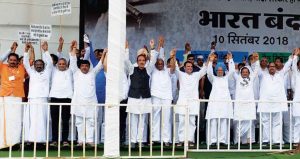
Indian currency has fallen more than 12 per cent on a year-to-date basis, making it one of the worst performing currencies among emerging markets. The trends indicate that the pain might not be just over yet. Finance Minister Arun Jaitley attributed the fall in rupee to global factors and said there was no need for panic or knee-jerk reactions since the RBI was doing whatever is necessary to deal with the situation. Finance minister Arun Jaitley tried to comfort the market by saying that the global risk aversion towards emerging market currencies was due to the recent developments in Turkey.
It was expected that Prime Minister Narendra Modi’s speech on the occasion of Independence Day, which was focused on India’s socio-economic development, would halt this free fall when the markets reopened. However, contrary to expectations, the skeptics had a field day and rupee, showed no signs of recovering and had fallen to a record low. However, Finance Minister’s statement that ‘India’s macro fundamentals remain resilient’ was, indeed, reassuring, especially when the country is back on the higher growth trajectory after showing a robust GDP rate of 8.2 per cent. The growth rate made India, the fastest growing economy of the world, even beating China in the game, but ironically worst was not over.
All parameters suggest that the bearish trends would continue and rupee might weaken further. In fact the rupee had its worst month in three years in August, 2018 as crude rallied on speculation sanctions on Iran will shrink global supplies. The crude import bill for the world’s fastest-growing oil user surged 76 per cent in July from a year earlier to $10.2 billion. That pushed up the trade deficit to $18 billion, the most in five years. Why worst is not over yet and pain still to continue is because India imports nearly 83 per cent of its crude oil requirement.
The rising crude oil prices have deepened concerns about the country’s current account deficit and inflation dynamics as the downslide of the rupee against the dollar continues unabated. About three months ago, it fell to a 15-month low. And now it has plummeted below the psychological 72-mark. While the cushion of over $400 billion forex reserve is comforting, the latest data indicates softening of inflation. The trade war between the US and China and the spat between Turkey and America is another cause of concern. Currency depreciation for any developing economy could be a major stumbling block in its growth. It calls for measures to encourage exports and strengthen manufacturing sector to reduce import overdependence. Prime Minister’s “Make In India” should be given a further push to give required impetus to manufacturing sector to avoid over-dependence on imports.
Continued strengthening of the US dollar, lack of foreign direct investment (FDI) and concerns over rising oil prices are likely to keep the rupee under pressure and push it further down against the US dollar. Analysts said trade war between China and the US is putting pressure on all the Asian currencies, but rupee is the worst hit so far. Foreign portfolio inflows into the domestic equity market have also come down due to the worries over US-China trade war.
EX-ALLY HITS OUT
N Chandrababu Naidu, the chief of the Telugu Desam Party that was part of the ruling NDA till recently, has launched a sharp attack on the BJP-led national coalition over the weakening of the rupee against the dollar and the increase in fuel prices. “Where are we heading to,” the Andhra Pradesh chief minister, the former ally of the BJP who turned into its sharpest critic this year, asked, blaming what he described were the faulty policies of Prime Minister Narendra Modi’s government.
“The value of rupee is falling down rapidly with every passing day. I am not surprised if it touches 100 per dollar in the coming days. The prices of petrol and diesel are shooting up steeply and very soon, the price of petrol might touch Rs 100 per litre.” Naidu said at a media conference in Amaravati where his government the state’s new capital. “They are going to hit a century. And, the rupee will also touch the century mark. You can then buy petrol paying a dollar.” Naidu was unsparing in his attacks on the centre for the state of the economy as well. He claimed that the economy had collapsed in the last two years and “the growth rate is on the decline too… There is no financial discipline in the country now,” the chief minister rued.
The Telugu Desam Party had earlier this year ended its four-year-long alliance with the BJP, complaining that PM Modi did not deliver on his promise to give Andhra Pradesh a special category status that could have given the state access to higher central funding. The TDP’s exit from the national coalition also coincided with sharper attacks on the centre on the economy and his assessment of PM Narendra Modi’s surprise decision to ban high value currency notes in 2016. An early supporter of the currency ban to unearth black money, the chief minister wondered what the centre had achieved by going in for demonetisation. “Every citizen of the country has suffered a lot due to demonetisation. Even now, liquid cash is not available and people are not able to draw money from ATMs,” he said.
Naidu, who was appointed as the convenor of the committee on digital economy soon after the demonetisation, recalled that he had suggested banning of currency of 2,000 and 500 denomination and printing of more 200 and 100 notes so as to help the common man, besides recommending digital currency for higher transactions. “But the NDA government did the exact opposite to what I had suggested as the convenor of digital economy. I demand that the Modi government ban 2,000 and 500 notes at least now and make smaller currency available for the people,” he said.
Delhi Chief Minister Arvind Kejriwal has hit out at prime minister Narendra Modi on the declining rupee vs dollar rate, and the hike in the price of petrol and diesel. Accusing Modi of doing the same thing that he used to blame the Congress for during the United Progressive Alliance regime, the Aam Aadmi Party (AAP) leader said: “Prime minister (Modi) used to talk a lot about rupee and petrol before becoming the prime minister. But now, the BJP is saying what the Congress used to say. Earlier, the Congress was responsible for inflation, now it is the BJP. The common man is the one who is suffering,” he added
BANKERS’ TAKE
A cross section of bankers observe that the Reserve Bank of India (RBI), however, will not be comfortable with the currency touching 70 against the dollar and will strongly defend the domestic currency. “Concerns over widening current account deficit due to higher crude prices and demand for dollar from oil companies and general importers are impacting the rupee, “said a senior bank official. Those companies who have to repay their external commercial borrowing (ECB) debt are also stocking up the US currency, a bank treasurer said.
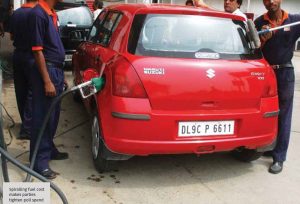 The apex bank has always stated that it does not target any level of the domestic currency but intervenes in the foreign exchange (forex) market to check its volatility. The forex reserves at $406.058 billion as of June 29, gives RBI enough comfort to intervene in the forex market. The rupee has depreciated as consistent dollar demand from banks and importers, mainly oil refiners, following higher crude oil prices kept the rupee under pressure. Global oil prices have climbed after the US asked its allies to end all imports of Iranian oil by November. Concerns over supply disruptions in Libya and Canada also pushed prices higher. Brent crude was trading at nearly $78 a barrel in Asian trade these days.
The apex bank has always stated that it does not target any level of the domestic currency but intervenes in the foreign exchange (forex) market to check its volatility. The forex reserves at $406.058 billion as of June 29, gives RBI enough comfort to intervene in the forex market. The rupee has depreciated as consistent dollar demand from banks and importers, mainly oil refiners, following higher crude oil prices kept the rupee under pressure. Global oil prices have climbed after the US asked its allies to end all imports of Iranian oil by November. Concerns over supply disruptions in Libya and Canada also pushed prices higher. Brent crude was trading at nearly $78 a barrel in Asian trade these days.
Given that India is the world’s third largest oil importer, any hike in global oil prices will inflate the import bill and disrupt the fiscal position. India’s current account deficit (CAD) has already widened 42 per cent year-on-year to $160 billion in FY18, and a high deficit means the country has to sell rupees and buy dollars to pay its bills. This further reduces the value of the rupee.
The sustained foreign capital outflows have also played a big role. Foreign portfolio investors have pulled out more than 46,600 crore from the capital markets in the year so far. However, the major factor weighing down the rupee is the ongoing trade turmoil between the world’s two largest economies, the US and China and fears of its escalation, which continues to hit forex market sentiments. A depreciating rupee could put inflationary pressure on the economy. Petrol and diesel prices have risen for the 10th consecutive day and currently petrol is priced at 79.31 per litre and 86.72 per litre in Delhi and Mumbai. Petrol prices in Kolkata and Chennai are 82.22 per litre and 82.41 per litre. Diesel is priced at 71.34 in Delhi, 74.19 in Kolkata, 75.74 in Mumbai and 75.39 in Chennai. CoverStory Spiralling fuel cost makes parties tighten poll spend
OPPOSITION OUTCRY
After having focused its attention on the Rafale deal, unemployment and agrarian distress, the principal opposition party, Congress is now planning a nationwide protest by all Opposition parties against rising prices. Congress spokesperson Manish Tewari said that if the government does not reduce fuel prices immediately, the party will launch nationwide protests and also hold a joint rally on the issue. “We will hit streets over the hike… There will be nationwide and elaborate protests from Kashmir to Kanyakumari.”
A meeting has been called to give a final shape to the agitation programme,” he said. Consumer price inflation in July rose 4.17 per cent compared with the same month a year ago, declining from a five-month high of 4.9 per cent in June, according to data from the Central Statistics Office. Then there are cascading effects of rising petrol and diesel prices on overall cost of living of common people. Fuel prices have increased for the tenth consecutive day. Led by a spike in global crude oil prices and the depreciating rupee, the prices of petrol and diesel have surged to record highs.
The Congress aims to build a narrative around the price rise in a manner similar to what the Bharatiya Janata Party (BJP) had done before the 2014 Lok Sabha elections. Congress leaders argue that the common people could be hit hard by the increase in fuel prices given that they have a spiraling effect on the rates of the essential commodities. The Congress has also asked its frontal organizations to gear up for the nationwide agitation. Youth Congress workers, led by their chief Keshav Chand Yadav, have already staged a protest against the “highest ever fuel prices” in Delhi outside the office of the petroleum and natural gas ministry.
BITTER TWEET
Former finance minister P Chidambaram attributed the rising petrol and diesel prices to “excessive taxes”. Taking to his Twitter account Chidambaram tweeted: “Relentless rise in prices of petrol and diesel is not inevitable. Because, the price is built up by excessive taxes on petrol and diesel. If taxes are cut, prices will decline significantly.”
He also termed a “spurious argument” the Central government’s blaming of the states for the problem. “The BJP forgets that its boast that BJP is ruling 19 States. Centre and States must act together and bring petrol and diesel under GST. Congress demands that petrol and diesel be brought under GST immediately,” he said.
Meanwhile, former finance minister Yashwant Sinha also blamed the Centre for unprecedented hike in prices of petrol and diesel and asked why the opposition was not out on the streets to protest. “Petrol, diesel and gas prices are rising and are hitting all time highs daily. Why are opposition parties not hitting the streets? What are they waiting for?” tweeted the former Bharatiya Janata Party (BJP) leader.
Petrol and diesel prices have risen for the 10th consecutive day and petrol is priced at 79.31 per litre and 86.72 per litre in Delhi and Mumbai. Petrol prices in Kolkata and Chennai are 82.22 per litre and 82.41 per litre. Diesel is priced at 71.34 in Delhi, 74.19 in Kolkata, 75.74 in Mumbai and 75.39 in Chennai.
The ruling Biju Janata Dal (BJD) in Odisha too has come down heavily on the BJP-led National Democratic Alliance (NDA) government over the “unprecedented” fuel price increase. The party said fuel prices had gone beyond control as the NDA government “failed to take concrete steps” to tackle the situation. In a statement, the BJD said it would hold a statewide agitation in coming days in protest against the rise in fuel prices.
Former finance minister Yashwant Sinha has also blamed the Centre for unprecedented hike in prices of petrol and diesel and asked why the opposition was not out on the streets to protest. “Petrol, diesel and gas prices are rising and are hitting all time highs daily. Why are opposition parties not hitting the streets? What are they waiting for?” tweeted the former BJP leader.
LETTERS@TEHELKA.COM

